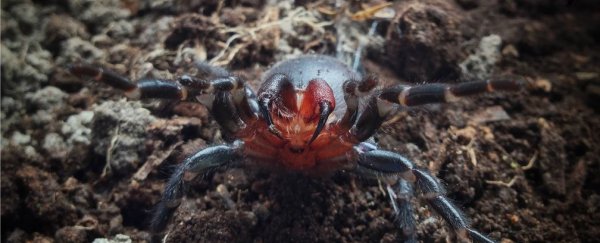
Researchers in Australia have discovered a never-before-seen type of funnel web spider with a bright red fang in the Tallaganda State Forest in New South Wales, southeast of Canberra. And as you can see in the only known footage of the individual above, it's pretty feisty.
The beautifully coloured specimen, which is around 5cm long, belongs to the elusive Atrax sutherlandi species, which is closely related to the infamous Sydney funnel-web spider (Atrax robustus).
But what makes this individual so unusual is that A. sutherlandi generally don't look like this - they're normally a glossy black all over without a hint of red, as our editor Bec Crew reports for Australian Geographic.
"Instantly taken aback by her colours, I knew there and then, this was something special," Mark Wong, a zoologist from the Australian National University who discovered the specimen, told Bec. He discovered the spider in an extensive web network on the forest floor during a routine collecting trip.
So what's behind that blood-red fang? Wong explains that other A. sutherlandi and Sydney funnel-webs have been seen with patches of red colouring before, which suggests that a genetic mutation is triggering the production of the pigment.
"So what we are seeing in this particular specimen may be a case where the genes for red pigment are being expressed in the wrong tissue," said Wong. "Alternatively, it is possible that 'normal' funnel-web spiders do actually express red pigment in the areas that show up clearly in this 'special' specimen, but it's just that the red is usually obscured by brown or black melanin in the 'normal' spiders … Perhaps in this specimen, the melanin genes have not been expressed, thus revealing the red pigmentation underneath."
Just yesterday, a separate group of researchers from the Australian National University announced they'd also found an individual that potentially represents a whole new species of funnel-web in Booderee National Park near Jervis Bay, south of Sydney.
Genetic testing is needed to confirm if the specimen is a new species, but for now they believe it belongs to the Hadronyche genus, which lives in trees, rather than the ground-dwelling Atrax genus. What they do know is that the individual is really old, and has potentially lived up to 30 years.
"The spiders moult as they approach maturity and judging by her size we are able to estimate that she was probably around about 25 to 30 years," Thomas Wallenius, a biologist who helped find the specimen, told Alkira Reinfrank from the ABC. "We are not entirely sure how long they do live for… but the upper limits of age may be further than 30 years."
Here's what that one looks like:
 Thomas Wallenius/ANU
Thomas Wallenius/ANU
While we're always excited by new scientific finds, we also can't help but feel a whole lot of NOPE about the discovery of two strange new funnel-webs in one week. Thanks for keeping us on our toes, Australia.
